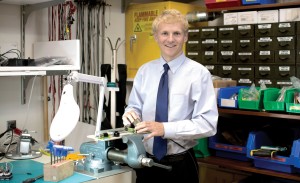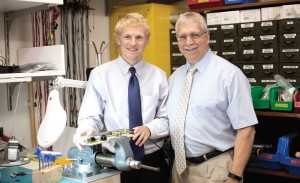Engineering student works in lab of SDSU Distinguished Alum
Peder Solberg’s day at Mayo Clinic begins early—a 7 a.m. meeting in the Motion Analysis Lab within the renowned hospital and research facility’s Department of Orthopedic Surgery.
The lab, directed by SDSU Distinguished Alumnus Kenton Kaufman, specializes in the analysis of walking gait, range of motion, strength, foot pressure and balance of patients with a wide variety of conditions. It serves both clinical and research operations. Today’s meeting is a gait conference with a patient’s attending physical therapist.
“The therapist uses data gathered in our lab to present the gait diagnosis to a surgeon or other physician, who then uses the data and discussion to decide what the next steps are for the patient.
“Today, the patient being analyzed is a child with a rare brain disorder that affects her ability to run without tripping. By the end of the meeting, the orthopedic surgeon has an idea of what muscle movement surgeries might allow the patient to move more effectively,†Solberg said.
The responsibilities are significant, especially since Solberg was a participant in Mayo’s Summer Undergraduate Research Fellowship. The mechanical engineering major will graduate in May 2019. He was one of three Jackrabbits accepted for the Mayo Clinic Graduate School of Biomedical Sciences program. A total of 144 students were chosen from 1,318 applicants.
Solberg spent 10 weeks working with Kaufman, an engineer by training, who received his bachelor’s and master’s in ag engineering from SDSU in 1974 and 1976, respectively.
The other two South Dakota State participants were Amanda Muller, a senior electrical engineering major, and Ella Lee, a junior microbiology and biotechnology major. Each had their own research project and Mayo faculty mentor.
From ag engineering to Mayo

Peder Solberg worked with Kenton Kaufman ’75/M.S. ’76 in the Motion Analysis Lab at the Mayo Clinic.
Solberg said, “I interact with Dr. Kaufman on a daily basis. He is the primary adviser for both the projects I am working on. He’s a wonderful adviser to have—very passionate about approaching things from an engineering perspective. My time working for him this summer has definitely taught me what it means to think like an engineer.â€
While Solberg is pursuing a biomedical engineering minor, Kaufman’s educational background didn’t hint at a career of more than two decades at Mayo. However, as a graduate research assistant at SDSU in 1975-76, the Freeman native did establish a human thermal comfort basis in air-conditioned tractor cabs.
His next 10 years (1976-86) were spent teaching in the ag engineering department at North Dakota State University.
It was there that Kaufman, an assistant professor teaching classes in power and machinery, met Dr. Edmund Chao, head of the orthopedic biomechanics lab at Mayo. The occasion was a class in human factors, to which Chao came to speak. Kaufman learned that Chao had the same background training he did. Kaufman ended up earning a doctorate in biomechanical engineering with Chao as his adviser.
Kaufman spent six years directing the motion analysis lab at Children’s Hospital in San Diego before settling in at Mayo in 1996, replacing the retired Chao.
Drinking out of a fire hydrant
Kaufman started working with students in the Summer Undergraduate Research Fellowship shortly after starting at Mayo. His first SDSU participant was Jonathon Adams in 2001. He now is a cardiologist. Four others preceded Solberg—Whitney Karpen, 2005-07; John Isenberg, 2006; Trevor Kjellsen, 2012; and Anthony Anderson, 2015.
Anyone entering the program already has a sparkling academic record. What distinguishes one from the other 140 accepted each year?
“Being a well-rounded person because they’re going to interact with medical professionals and other patients when they’re here,†Kaufman said. Solberg impresses Kaufman because “he’s very well trained. He’s gotten an excellent education at South Dakota State University. He also knows his limits. He knows when he needs assistance, when to ask questions and get help.â€
Solberg said, “Coming here as a student is like taking a drink out of a fire hydrant, in the best sense possible. There are so many opportunities to learn from the best in the world.â€
But the White Bear Lake, Minnesota, resident also has proven to be quite a sponge.
Regarding the aforementioned meeting in the Motion Analysis Lab, Solberg said, “I take it all in, noting how the clinical staff make decisions and interact with the presentation of data gathered in our lab. This is important because one of my projects involves analysis of walking gait to quantify balance during turns, and my other project involves design of a medical exoskeleton. I want to make sure that the graphs I create or the device I design will be useable in a clinical setting like this.
“Eventually, the work I am doing could affect a patient’s quality of life after a surgery, or whether or not a soldier with a traumatic brain injury is allowed to return to active duty, so I want to make sure I understand the clinical decision-making process that my work could impact.â€
What’s next for Solberg
This summer has left Solberg with his own decisions to make.
“In the spring semester 2018 I really had a strong inkling that the medicine side of engineering was what I wanted to do. I took an anatomy class for my biomedical engineering minor and learned the structure and processes of the human body. The engineering lens I view the human body through is different from what most people in the medicine field have.
“Coming to Mayo this summer has further solidified that. I want to be involved in the design of medical devices,†Solberg said.
The decision is what he will do after graduation in May. He had thought he would get a master’s degree before going to work in private industry. Now he is considering graduate school at Mayo, which is a five-year commitment on a doctorate-only track. The fellowship is considered a courtship for both Mayo and the student.
“Seeing how engineering can be used to solve medical problems and cure diseases has been very valuable to me. It’s a very rewarding field—one I’d like to have a career in,†he said.
Dave Graves






